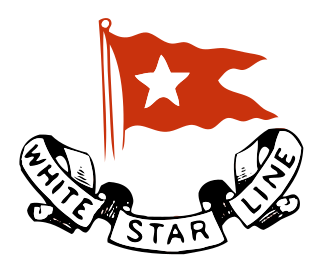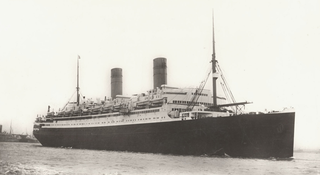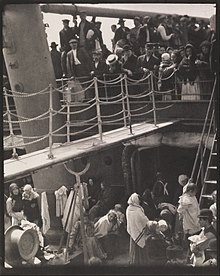
Kaiser Wilhelm der Grosse was a German transatlantic ocean liner in service from 1897 to 1914, when she was scuttled in battle. She was the largest ship in the world for a time, and held the Blue Riband until Cunard Line’s RMS Lusitania entered service in 1907. The vessel’s career was relatively uneventful, despite a refit in 1913.

The White Star Line was a British shipping line. Founded out of the remains of a defunct packet company, it gradually rose up to become one of the most prominent shipping companies in the world, providing passenger and cargo services between the British Empire and the United States. While many other shipping lines focused primarily on speed, White Star branded their services by focusing more on providing comfortable passages for both upper class travellers and immigrants.

The first USS Amphion was a former German passenger liner SS Köln for Norddeutscher Lloyd from 1899–1917. Köln had been interned in Boston on the outbreak of war in Europe and confiscated in April 1917 when the United States entered the war. The ship was under the control of the United States Shipping Board (USSB) that allocated commercial type ships to military or civilian use during the war. Köln was renamed Amphion and operated by USSB for the Army as United States Army Chartered Transport (U.S.A.C.T.) Amphion as an animal transport taking mules, horses and general cargo to forces in Europe. At the end of the war the USSB allocated the ship to the Navy, which used the ship from April to September 1919 as a troop transport for returning the United States Expeditionary Force from Europe.

SS Kaiser Wilhelm II was a Norddeutscher Lloyd (NDL) Kaiser-class ocean liner. She was launched in 1902 in Stettin, Germany. In the First World War she was laid up in New York from 1914 until 1917, when the US Government seized her and renamed her USS Agamemnon. In 1919 she was decommissioned from the Navy and laid up. In 1927 she was transferred to the United States Army, who renamed her USAT Monticello. She was scrapped in 1940.
Economy class, also called third class, coach class, steerage, or to distinguish it from the slightly more expensive premium economy class, standard economy class or budget economy class, is the lowest travel class of seating in air travel, rail travel, and sometimes ferry or maritime travel. Historically, this travel class has been called tourist class or third class on ocean liners.
Norddeutscher Lloyd was a German shipping company. It was founded by Hermann Henrich Meier and Eduard Crüsemann in Bremen on 20 February 1857. It developed into one of the most important German shipping companies of the late 19th and early 20th centuries, and was instrumental in the economic development of Bremen and Bremerhaven. On 1 September 1970, the company merged with Hamburg America Line (HAPAG) to form Hapag-Lloyd AG.

SS City of Glasgow of 1850 was a single-screw passenger steamship of the Inman Line, which disappeared en route from Liverpool to Philadelphia in March 1854 with 480 passengers and crew. Based on ideas pioneered by Isambard Kingdom Brunel's SS Great Britain of 1845, City of Glasgow established that Atlantic steamships could be operated profitably without government subsidy. After a refit in 1852, she was also the first Atlantic steamship to carry steerage passengers, representing a significant improvement in the conditions experienced by immigrants. In March 1854 City of Glasgow vanished at sea with no known survivors.

SS Britannic was an ocean liner of the White Star Line. She was the first of three ships of the White Star Line to sail with the Britannic name.

RMS Homeric, originally launched as Columbus, was an ocean liner built for Norddeutscher Lloyd and launched in 1913 at the F. Schichau yard in Danzig, Germany. Columbus was ceded to Great Britain in 1919 as part of German war reparations. She was sold to the White Star Line in 1920, which named her Homeric. Her sister ship Hindenburg remained in German ownership and was renamed Columbus. Homeric was operated by White Star from 1922 to 1935.

The Inman Line was one of the three largest 19th-century British passenger shipping companies on the North Atlantic, along with the White Star Line and Cunard Line. Founded in 1850, it was absorbed in 1893 into American Line. The firm's formal name for much of its history was the Liverpool, Philadelphia and New York Steamship Company, but it was also variously known as the Liverpool and Philadelphia Steamship Company, as Inman Steamship Company, Limited, and, in the last few years before absorption, as the Inman and International Steamship Company.

SS Saale was an ocean liner for North German Lloyd in the late 19th century, which was severely damaged in the 1900 Hoboken Docks Fire. On 30 June 1900, Saale was moored at the North German Lloyd piers in Hoboken, New Jersey, preparing to depart on a transatlantic crossing when some cotton on a nearby pier caught on fire and spread to the ship. Saale and several other ships were soon engulfed in flames; 99 passengers and crew on Saale were killed in the fire and subsequent sinking.

RMS Teutonic was an ocean liner built for the White Star Line in Belfast and was the first armed merchant cruiser.

SS Elbe was a transatlantic ocean liner built in the Govan Shipyard of John Elder & Company Ltd., Glasgow, in 1881 for the Norddeutscher Lloyd of Bremen. She foundered on the night of 30 January 1895 following a collision in the North Sea with the steamship Crathie, resulting in the loss of 334 lives.

SS Monroe was an Old Dominion Steamship Company steamship launched 18 October 1902 and completed 3 April 1903 by Newport News Shipbuilding of Norfolk, Virginia for operation in the company's Old Dominion Line's "Main Line Division" for overnight service between New York and Norfolk and could make 16 knots (30 km/h). The ship had accommodations for 150 first class, 78 steerage and 53 deck passengers. That service was between New York pier 26, North River, and Norfolk connecting with the line's "Virginia Division" steamers, including Old Dominion's "Night Line Steamers" Berkley and Brandon serving Richmond with overnight service to Norfolk, other steamer lines and rail lines serving the Chesapeake Bay area. The Monroe was struck at about 2 a.m. on 30 January 1914 by the southbound steamer Nantucket and sank with loss of forty-one lives.

The Oceanic class were a group of six ocean liners built by Harland and Wolff at Belfast, for the White Star Line, for the transatlantic service. They were the company's first generation of steamships to serve the North Atlantic passenger trade, entering service between 1871 and 1872.

SS Burdigala was an ocean liner that sailed the Atlantic Ocean from 1898 until World War I. The ship was built as the Kaiser Friedrich in 1898 for Norddeutscher Lloyd (NDL), a German shipping line. Designed to break the speed record for a transatlantic liner and thereby win the Blue Riband, the Kaiser Friedrich never achieved the necessary speeds. After a short career with NDL and an equally short period of service with NDL's main German competitor, the Hamburg-Amerikanische Packetfahrt-Aktien-Gesellschaft, the ship was mothballed for a decade. After being sold to the French shipping line Compagnie de Navigation Sud-Atlantique, it re-entered service as SS Burdigala. In 1916, while en route from Thessaloniki to Toulon, the liner struck a mine laid by the German U-boat U-73 in the Aegean Sea and sank near Kea, Greece.

The Steerage Act of 1819, also called the Manifest of Immigrants Act, was an Act passed by the United States federal government on March 2, 1819, effective January 1, 1820. Its full name is An Act regulating passenger ships and vessels. It was the first law in the United States regulating the conditions of transportation used by people arriving and departing by sea. In addition to regulating conditions in ships, the act also required ship captains to deliver and report a list of passengers with their demographic information to the district collector. The Act was passed near the end of the term of the fifteenth United States Congress and signed into law by then United States President James Monroe. The Act was augmented by many additional Acts starting 1847 and finally repealed and superseded by the Carriage of Passengers Act of 1855. At the time of passage of the Act, the United States had no laws restricting immigration. In fact, the first federal legislation regulating immigration, the Page Act of 1875, was over 50 years in the future.

The Carriage of Passengers Act of 1855 was an act passed by the United States federal government on March 3, 1855, replacing the previous Steerage Act of 1819 and a number of acts passed between 1847 and 1849 with new regulations on the conditions of sea transportation used by passenger ships landing in the United States. The law was passed by the 33rd United States Congress and signed into law by President Franklin Pierce.

The GG Archives is a large, privately held archive of genealogy, military, and other ephemera dating from the mid-1800s through 2000. The site has over 6,000 static web pages and 20,000 images. The archives are composed of artificial collections of ephemera in twelve topical areas. The site has since received numerous awards.

The Lloyd Hall (German:Lloydhalle) was a passenger terminal in Bremerhaven, at the "Kaiserhafen I" dock, was built in 1870, rebuilt in 1897, and destroyed in 1944 during World War II.



















